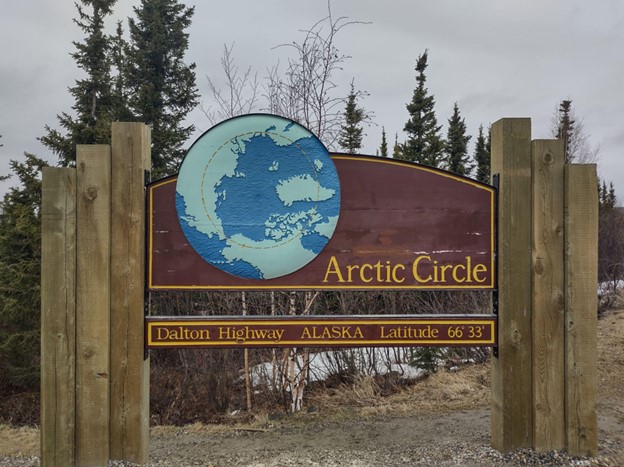Did you know only 2% of visitors to Alaska make the journey to the Arctic Circle? Now, that’s an elite group. Vast and remote, as you drive and drive and drive, the region’s lush boreal forest gives way to the barren tundra, a turf inhospitable to even the most intrepid of travelers. Intimidating and awe-inspiring all at once, a touch of nerves (and excitement) set in as it becomes undeniably apparent that you are, in fact, nearing the top of the world.
As far as roadside attractions go, there isn’t much to see. It’s just you and the purest of nature.
Your guiding light is the Trans-Alaska Pipeline, an engineering wonder made from concrete and steel stretching hundreds of miles in search of its terminus in Prudhoe Bay. It’s your one constant in the Alaskan wilderness as you travel the rugged Dalton Highway, a two-lane dirt road frequented only by truckers, construction workers and daring tour groups such as yours.

The average Joe doesn’t come out here, but this isn’t your average drive. Instead, the journey is rough, akin to driving over rumble strips and potholes for hours on end. And one hundred miles on the Dalton Highway doesn’t equate to one hundred miles on the average city highway. Drivers must travel slowly, so slowly, in fact, it takes more than seven hours to drive the 200 miles from Fairbanks to the Arctic Circle going one way.
Luckily, there are pitstops along the way. The Arctic Circle Trading Post and Yukon River Camp act as places to stretch your legs, a much-welcomed encounter with human life between vast stretches far from modern civilization. Both tiny holes in the wall, these establishments are like a mirage in the desert for weary travelers offering a quick bite to eat and a chance for a dignified bathroom break. And while there may be other travelers, it’s not uncommon to be the only group or person in sight. You are off the grid, after all.

Upon departing Yukon River Camp it’s time to embark on the final leg of your journey to the Arctic Circle. Panoramic views fly by, fields painted in shades of green, red and yellow in the rearview. You keep your eyes peeled for cold-weather wildlife, caribou, arctic hares, lemmings and voles are common this far north. Migratory birds are often spotted too, and with such little traffic, no one minds if you pull off to the side to snap a photo or two.
Finally, when you’ve been driving for so long you’ve forgotten where you’re going, you veer toward a small parking lot off the right side of the road, a sign reading “Arctic Circle” in view. A buzz begins to grow among your fellow tour-goers, and you realize the spot is quite ordinary marked only by a gravel lot, a few picnic tables, a lookout deck and a giant wooden sign. There is no fanfare, but still, the moment is so special. You’re standing in one of the few places on Earth where the sun doesn’t set on the summer solstice and doesn’t rise on the winter solstice. A living part of a geographical anomaly witnessed by so few people. It’s pretty epic.

The Arctic Circle sign becomes the main attraction as everyone clamors for a selfie to prove they did in fact do the thing. At one point, your guide literally rolls out the red carpet for those looking to cross 66°33′ N in style. And although all you did was endure a seven-hour bus ride, it feels like an accomplishment, you made it to the top of the world, baby!
As green spruce trees dance and friendly Arctic birds gather near, eager to accept any tasty snacks that might get left behind, a feeling of peace sets in. When you stop to listen, a wave of quiet washes over you, a calm we so rarely get to experience. Stop for a minute, really take it all in.
Originally Sourced from The Compass – Jenna Buege

